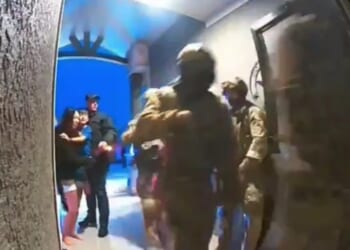Russia’s Su-57 stealth fighter features a customizable AI “co-pilot” for flight and combat support. Displayed at LIMA 2025, the system enhances pilot efficiency but faces modernization challenges under sanctions.
The Russian Aerospace Force’s fifth-generation stealth fighter, the Sukhoi Su-57, could eventually be supported by the S-70 Okhotnik unmanned aerial system (UAS). The UAS promises to serve as a loyal wingman and increase the combat capabilities of the manned aircraft.
It may not be the only autonomous platform to enhance the Su-57.
The United Aircraft Corporation (UAC) has been touting the aircraft’s integrated artificial intelligence (AI) assistance system, which serves as a virtual “co-pilot” in the single-seat multirole fighter, at the Langkawi International Maritime and Aerospace (LIMA) Exhibition 2025 in Malaysia.
According to a report from international military analyst firm Janes, the AI functionality will be included with the export model of the Su-57 fighter. Janes cited a Rosoboronexport official who explained that the AI assistant was integrated into the aircraft to provide support to the pilot during “routine flight operations” and “in combat scenarios.”
Though details of the systems remain sparse, it was confirmed that the AI system could be included in Su-57 aircraft “offered for export.”
What Is the Su-57’s Digital Co-Pilot?
UAC has claimed that the manned fighter is outfitted with an advanced onboard computer that can act as a “second pilot,” assisting the human operator during combat sorties. The computer can identify potential threats and handle routine flight operations, enabling the pilot to focus on the mission’s objectives.
“The system [is designed to] provide tips to the pilot in specific … situations and during tactical moments,” the Rosoboronexport official told Janes.
“The system is designed to assist the human pilot by taking over aspects of routine flight operations, such as waypoint navigation and flight systems management,” the Russian source added.
The pilot will be able to focus on the “critical tasks,” including weapons launch, while the Rosoboronexport official reaffirmed that the “release of weapons remains with the human pilot.”
The system was also described as highly customizable and based on the needs of the human pilot.
“Experienced pilots may need minimal use of the AI. However, new pilots to the Su-57 can make greater use of the AI’s functions. This is all up to the customer,” the UAC source explained.
Questions remain, however.
Though this virtual pilot has been a key component of the Su-57 since the fighter’s earliest development, it is unclear how the computer’s software and hardware have kept pace with technological advances, including the introduction of large language models and generative AI.
The Lockheed Martin F-35 Lightning II, arguably the most advanced and capable fifth-generation fighter in service today, has been plagued by its Technology Refresh-3 (TR-3) hardware/software upgrade that even sidelined deliveries for a year.
Given the sanctions that Moscow faces, it is hard to imagine that the Russian aircraft can continue to upgrade an automated platform that can keep pace with advances in computer technology.
The Su-57 Shows Off the New Co-Pilot System at Another Foreign Air Show
Rosoboronexport has taken the Su-57E, the export model of the fifth-generation fighter, to the LIMA Exhibition. This follows a presentation of the aircraft at arms exhibitions and air shows in Egypt, China, and India. UAC has sought to find foreign buyers, but they have failed to materialize thus far.
It doesn’t seem the situation will be much different in Malaysia, but Rosoboronexport may see it differently.
“The aviation component is the exhibition’s main theme. The company will feature the latest Russian Su-57E fifth-generation fighter in this segment, which will interest Malaysian Royal Air Force representatives and other Southeast Asian countries.
Its basic advantage before a small group of rivals is its successful combat experience in a real armed conflict amid the enemy’s use of advanced aerial attack, AI defense, and electronic warfare capabilities,” the Rosoboronexport press office said in a statement to state news agency TASS.
That is the same pitch to likely many of the same potential buyers, but by highlighting the AI, UAC will finally be able to close those deals.
About the Author: Peter Suciu
Peter Suciu has contributed over 3,200 published pieces to more than four dozen magazines and websites over a thirty-year career in journalism. He regularly writes about military hardware, firearms history, cybersecurity, politics, and international affairs. Peter is also a Contributing Writer for Forbes and Clearance Jobs. He is based in Michigan. You can follow him on Twitter: @PeterSuciu. You can email the author: [email protected].
Image Credit: Shutterstock/aarrows.

















